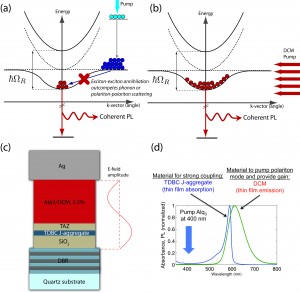Polariton Lasing by Intra-cavity Pumping and Applications to Ultra-fast Switching

Figure 1: (a) Non-resonant pumping scheme that is impeded by exciton annihilation, preventing polariton build up in the well. (b) Intra-cavity pumping scheme that populates polaritons along the entire dispersion curve. (c) Device structure. (d) Spectra showing the overlap of the emission of the DCM pump with the absorption of the strongly coupled J-aggregate.
The strongly coupled states of light and matter in microcavities known as polaritons offer exciting possibilities for the study of condensation, superfluidity, and other condensed matter phenomena and show promise as a radically new class of optoelectronic devices based on the macroscopic coherence of light and matter [1] . In particular, organic materials allow for strong coupling and polariton lasing to be achieved at room temperature and with substantially reduced requirements for cavity quality factor [2] [3] . In our work, we demonstrate room temperature polariton lasing in a lambda-thick microcavity where a highly absorbing thin film of J-aggregates serves as the strong coupling material (Figure 1c). Typically, polaritons in the cavity are created by excitation with non-resonant laser pulses. Subsequently, the hot excitons couple to the cavity and move along the polariton dispersion towards the bottom of the polariton trap (Figure 1a). However, a loss mechanism known as annihilation is present in organic materials which prevents a high density of polaritons from being formed in the trap, and hence polariton condensation (lasing) cannot be achieved. We employ a new pumping scheme known as intra-cavity pumping that circumvents annihilation losses inherent to organic materials at high excitation densities (Figure 1b) by pumping the polariton mode from within the cavity using another organic material (the laser dye DCM) (Figure 1c and 1d). Using this flexible cavity architecture, polariton lasing at room temperature has been achieved. Current work focuses on the application of the polariton laser as a low-energy, ultra-fast all-optical switch and on a better understanding of the properties of the polariton condensate.
- H. Deng and Y. Yamamoto, “Exciton-polariton Bose-Einstein condensation,” Reviews of Modern Physics, vol. 82, pp. 1489-1537, May 2010. [↩]
- S. Kéna-Cohen and S. R. Forrest, “Room-temperature polariton lasing in an organic single-crystal microcavity,” Nature Photonics, vol. 4, pp. 371-375, Apr. 2010. [↩]
- J. R. Tischler, M. S. Bradley, Q. Zhang, T. Atay, A. Nurmikko, and V. Bulovic, “Solid state cavity QED: Strong coupling in organic thin films,” Organic Electronics, vol. 8, pp. 94-113, 2007. [↩]